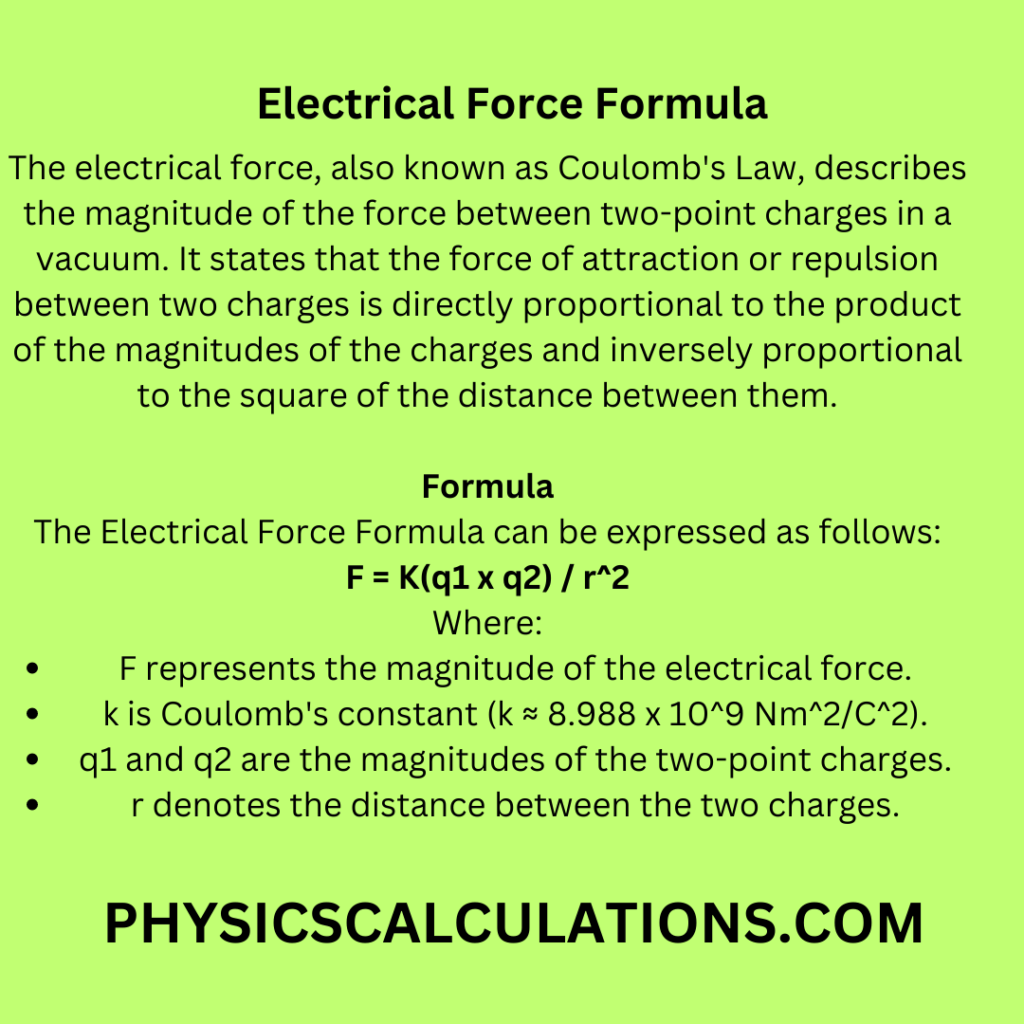What is the Electrical Force?
The electrical force, also known as Coulomb’s Law, describes the magnitude of the force between two-point charges in a vacuum. It states that the force of attraction or repulsion between two charges is directly proportional to the product of the magnitudes of the charges and inversely proportional to the square of the distance between them.
The Electrical Force Formula can be expressed as follows:
F = K(q1 * q2) / r2
Where:
- F represents the magnitude of the electrical force.
- k is Coulomb’s constant (k ≈ 8.988 * 109 Nm2/C2).
- q1 and q2 are the magnitudes of the two-point charges.
- r denotes the distance between the two charges.

Understanding the Components of the Formula
To gain a deeper insight into the electrical force, let us break down its components:
- Magnitude of Electrical Force (F): The magnitude of the force refers to the strength of the attraction or repulsion between two charges. Larger charges result in greater forces, while smaller charges lead to weaker forces.
- Coulomb’s Constant (k): Coulomb’s constant is a fundamental value used to calculate the force between two charges. It appears in the formula and is approximately (8.988 * 109 Nm2/C2).
- Magnitude of Point Charges (q1 and q2): These variables represent the quantities of charge possessed by the two particles involved. Charges with the same sign (both positive or both negative) repel each other, while opposite charges (one positive and one negative) attract.
- Distance Between Charges (r): The distance between the charges significantly impacts the force. As the distance increases, the force weakens, and vice versa.
Read: Charles’s Law Examples
Applications of the Electrical Force Formula
The formula finds widespread applications in various fields. Let’s explore some of its practical uses:
- Electrostatics: Coulomb’s Law is crucial in understanding the behaviour of electric charges at rest. It helps explain how objects become charged, the formation of static electricity, and the phenomena of attraction and repulsion.
- Electrical Engineering: In electrical engineering, the electrical force is fundamental to designing circuits, calculating capacitance, and determining the forces acting on charged particles in different configurations.
- Particle Physics: At the subatomic level, charged particles interact through electromagnetic forces, making the electrical force formula vital in studying particle interactions and building particle accelerators.
- Astrophysics: The formula plays a crucial role in understanding celestial bodies’ behaviour, such as the interaction between charged particles in space and the dynamics of charged particles within stars and galaxies.
- Medical Devices: Medical devices that rely on electrical interactions, such as defibrillators and pacemakers, use the electrical force formula to ensure precise functioning.
The Role of Electrical Force in Daily Life
The electrical force impacts our lives in more ways than we may realize. Consider the following scenarios:
- Charging Devices: When we charge our smartphones, laptops, or electric vehicles, the electrical force between the battery’s charged particles allows energy transfer and storage.
- Lightning and Thunderstorms: Lightning is a natural phenomenon resulting from the buildup of electrical charge in clouds and the subsequent discharge to the ground.
- Static Electricity: The electrical force explains why we experience static shocks after shuffling our feet on a carpet and touching a metal surface.
- Magnetism: Although magnetism is a separate force, it is inherently linked to electricity through electromagnetism, as described by the electrical force.
Safety Precautions in Electrical Environments
While electrical forces power our modern world, they also pose certain risks. Understanding and observing safety precautions is essential. Here are some tips:
- Electrical Appliances: Always use appliances with grounded plugs to prevent electrical shocks.
- High Voltage Areas: Stay clear of high voltage areas, and only allow trained professionals to handle electrical equipment.
- Overloading Circuits: Avoid overloading circuits to prevent fires and electrical damage.
- Water and Electricity: Keep electrical appliances away from water sources to avoid electrocution.
- Child Safety: Childproof electrical outlets to protect young children from potential hazards.
FAQs
Q: What is electrical force?
A: Electrical force is the fundamental force of nature responsible for the attraction and repulsion between charged particles.
Q: How is the electrical force formula derived?
A: The electrical force formula, also known as Coulomb’s Law, is derived through empirical experimentation and observation of the interactions between charged particles.
Q: Is electrical force the same as magnetic force?
A: No, electrical force and magnetic force are distinct phenomena, but they are interconnected through electromagnetism.
Q: What happens when two like charges come close together?
A: Two like charges (both positive or both negative) repel each other and tend to move apart.
Q: What practical application does the electrical force formula have in engineering?
A: Electrical force formula is used in electrical engineering to design circuits, calculate capacitance, and understand the behaviour of charged particles.
Q: How does electrical force impact the behaviour of celestial bodies?
A: Electrical force is instrumental in celestial bodies’ dynamics, influencing their orbits, interactions, and overall behaviour.
You may also like to read: